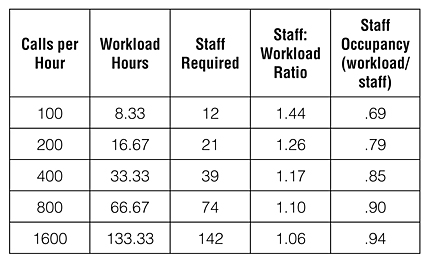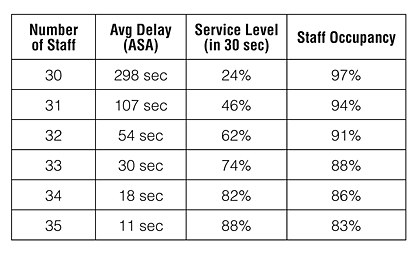|
Evaluating Staff, Cost, and Service Tradeoffs Running a successful call center operation means managing by the numbers. And the most important number of all is the magical quantity of staff that matches the workforce as closely as possible to the call center workload. In the previous article on Calculating Call Center Staff, we outlined the basic steps of calculating staff requirements – calculating workload, defining speed of answer goals, and applying a staffing model to determine the “just right” number of staff to meet service goals. This article takes a closer look at staffing requirements and the many factors that influence the staffing levels in your call center. In this article we’ll address the following common staffing questions:
Call Arrival Rate As discussed in the previous article, calls generally arrive at call centers in a random fashion – no particular pattern within the hour or half-hour. And because of this random pattern, a call center will always need more staff hours in place than the actual workload hours to be accomplished. On the other hand, if calls arrive in a smoother pattern (closer to a task after task paperwork environment), then the number of staff needed would be close to the workload hours. What contact center scenarios would represent this type of back-to-back work? We might expect to see outbound calling follow this pattern, especially if an automated dialer is in use. The workload (outbound calling) occurs in a back-to-back sequential pattern rather than a random one. Likewise, responding to emails typically represents sequential workload as well, assuming that personnel respond to these contacts one right behind the other. In both these cases, the number of staff required is equivalent to workload hours. On the other hand, what if the workload arrives in a peaked pattern rather than a smooth one? Let’s consider the call center that is responding to calls based on television advertising. There may be no calls arriving at 11:05, but a flood of calls arrives at 11:09 after an advertisement 11:08. And then the calls drop again at 11:15 but peak again at 11:25. This “all or nothing” pattern requires enough staff to be in place to handle peaks of calls when they arrive, meaning more staff would be required than a typical random pattern. If your traffic patterns resemble either of the extremes above, then the erlang traffic models typically used to calculate staff will either overstate or understate the staff needed. A model called Erlang-Engset is recommended for smooth workload situations, while an Equivalent Random Theory model is used for peaked arrival patterns. Agent Group Size Another factor that has a major impact on staffing is the size of the center or the agent group. Groups handling larger volumes of calls will naturally be more efficient than smaller groups. This is due to the economies of scale of large groups. As seen in the example below, doubling the call volume does not require two times the number of staff to meet the same service goal of 80% in 20 seconds. And when call volume increases eightfold, only about six times the number of staff are needed. As the volume grows, the staff to workload ratio gets smaller and smaller.
The reason for these increased efficiencies and the lower staff to workload ratio is simply that with a higher volume of calls, there’s a greater likelihood that when an agent is finished with a call, there’s another one coming in right behind it for that person to handle. With a bigger volume, each person has the opportunity to process more calls each hour. Each person spends less time in available state waiting on a call to arrive and with each person handling more calls, we don’t need as many staff. Staff Occupancy So if a higher volume of calls means that each person is busier, then you might assume that bigger is always better, right? After all, these folks are being paid to sit and handle calls, so don’t we want them busy all the time doing just that? The answer is yes…and no. While we want staff to be busy processing calls, having them too busy (in other words, no available time or “breather” between calls) isn’t such a good idea either. The measure of how busy agents are is called agent occupancy. It’s the percentage of logged in time that an agent is actually busy in talk or wrap-up time. It’s calculated by dividing the amount of workload by the staff hours in place. In the previous table, with 12 staff handling 8.33 hours of workload, agent occupancy is only 69%. At double the call volume with 21 staff in place, twice the workload is being handled without doubling the workforce, so each person is busier. In this case occupancy has increased to 79%. As the volume of calls grows, increased efficiencies and economies of scale come into effect, meaning occupancy goes higher and higher. And while we want our staff to be productive and busy, asking staff to stay occupied at a 94% rate is not realistic. Most call centers aim for the 85 – 90% range since occupancy rates higher than that lead to all kinds of undesirable call handling behaviors as well as a high turnover rate. Cost and Service Concerns A final staffing trade-off has to do with the relationship of staff to service and cost. All call centers these days are being asked to cut costs and to do more with fewer resources. Since about 75% of a total call center’s operating costs are related to staffing, that is generally the first place we look to reduce costs. It is all too common to think of layoffs and reduction in staff as a way to respond to the call from senior management to tighten belts. But before you write up the pink slips, make sure you understand the implications of staff reductions. Let’s assume that you’re a fairly small call center with fewer than 50 agent seats. (If you’re a larger center, you can view these numbers as representative of a specialized agent group within the bigger call center structure.) Most days you’re meeting your service goal of 70% in 30 seconds. The snapshot below indicates the staffing picture with varying numbers of staff during a half-hour in which you’re getting 175 calls.
As you can see, staffing with 33 “bodies in chairs” would enable you to meet service level fairly consistently. But the loss of one person would worsen service level from 74% to 62% (or average speed of answer from 30 seconds to 54 seconds). Eliminating another person would drop service level to 46%, and the average delay would double to 107 seconds! And reducing staffing levels by three would horribly deteriorate service level to only 24%, resulting in an average delay of 298 seconds! So those callers accustomed to waiting for only half a minute in queue would now be waiting nearly 5 minutes! And service isn’t the only thing that suffers. With 33 staff in place to handle the call workload, agent occupancy (the measure of how busy staff are during the period of time they’re logged in and available) is in a good range at 88%. Taking one body away raises occupancy levels to 91%; taking two away results in 94% occupancy; and taking three away means staff would be busy 97% of the time during the hour. In other words, there would be only 3% (108 seconds) of “breathing room” between calls. Such a high level of occupancy can’t be maintained for long. The likely result will be longer handle times, longer periods spent in after-call work to “catch their breath”, burnout, and turnover. And there’s another point to consider. The reduction in staff might be outweighed by the increased telephone costs associated with the longer delay times. In this example, with 33 staff in place the average delay is 30 seconds per call. Multiply that by 350 calls per hour and that’s 10,500 seconds (or 175 minutes) of delay. If we apply a fully loaded telephone cost per minute to that usage of $.06 per minute, that’s $10.50 for the queue time. If we try and staff with 30 staff, remember our average delay increases to 298 seconds of delay. Multiply that by 350 calls and that’s 1738 minutes of delay, priced at $.06 for a total of $104.30 for the queue time that hour. In other words, by eliminating three staff to save money, we’ve just increased our telephone bill by $ 93.80 for that hour! And this doesn’t even take into account the likelihood of a longer call given the poorer than expected service levels. Telephone charges would likely increase even further. This situation is even more dangerous in a revenue-producing center. If the value of a contact is $50, and agent salaries are $20 per hour, it is easy to see that putting another agent on the phone will pay for itself even if the agent only answers one call per hour that would otherwise have abandoned from the queue. But even if the value of the call is only $5, there is clearly a trade-off in determining the staffing level that will produce the highest net bottom line. The return on appropriate staffing must be argued against budget constraints. Next Steps Now that we’ve discussed most of the factors that affect the number of staff needed to handle the contacts half-hour by half hour, the next step is figuring out how to schedule in order to get the right number of people in place at the right times. In the next article in this series, we’ll discuss the basic steps of scheduling contact center staff in order to maximize service, minimize cost, and account for staff preferences. Copyright ©2008 Society of Workforce Planning Professionals. All rights reserved. |
||

